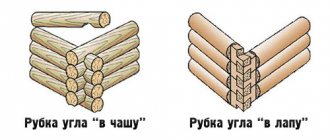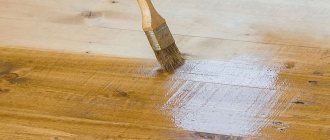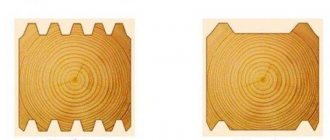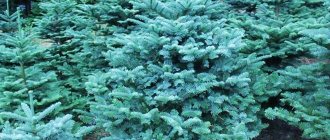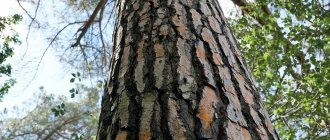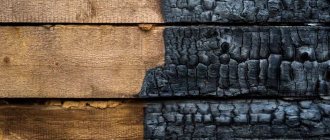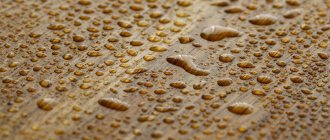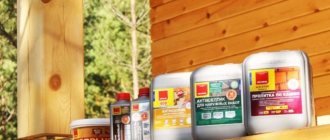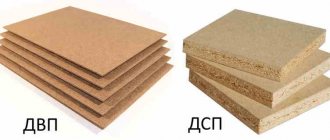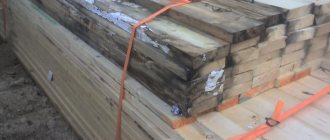White on black. All the most important things about wood bleaching
In the warm season - from late spring to mid-autumn - wood is especially vulnerable to mold and wood-staining fungi. They do not affect the physical and chemical properties of the material and do not destroy its structure, but cause significant damage to the appearance - it is because of them that blueness and blackening appear. It would seem that if such mushrooms do not destroy wood, then you can close your eyes to aesthetics and not worry. But it's not that simple. The lack of timely measures against wood-staining fungi leads to the fact that they prepare a breeding ground for their wood-destroying counterparts - and this is a serious cause for concern.
The color of wood exposed to the open air also changes due to exposure to ultraviolet radiation: at first it acquires a yellowish tint, which over the years turns into a dirty gray. Another scenario for changing the color of wood is the appearance of dark spots around metal fasteners. This process is non-fungal in nature, and we will talk about it in detail below.
What leads to a change in the natural color of wood
Destroys the color of wooden workpieces and microorganisms that develop on any material. It is quite possible to bleach blackened wood by finding out the causes of the stains. The lumber may become covered with blue or black spots. Durable wood can be susceptible to deterioration. Blackness can spread to pine and expensive oak.
Reasons for changing the color of wood include:
- errors during transportation;
- storage of lumber in unsuitable conditions;
- excessive lighting;
- storage in the rain;
- storage in an unventilated area.
Often, when carrying out repair work, it is necessary to remove stains from the workpiece. The technician will eliminate them, but if localized blackness remains, this will subsequently lead to the return of the mold.
Each type of wood has a characteristic color of the affected layer of material:
- oak becomes gilded;
- birch becomes covered with blue spots;
- dark ash becomes light;
- the nut takes on a bright red color.
The spread of microorganisms begins from small spots. Gradually the spots will grow and merge. If the affected surface is not treated, the process of damage to the wood will continue. It is necessary to cure blackened wood as quickly as possible.
Causes of fungus formation
Fungus and mold can develop on any wooden surface, regardless of lumber; even imitation timber and laminated veneer lumber are not immune to damage by microorganisms.
The type of wood also does not matter in this case; fungus can appear on both inexpensive pine and elite oak. A very common reason for the appearance of blue stains is improper transportation and violation of storage conditions of logs and timber. Lumber should be stored in a well-ventilated, dry place. It is advisable that the area is in the shade and that the tree is not exposed to precipitation.
Fungi that contribute to the formation of blue and gray plaque on wood develop very quickly, especially in suitable conditions. Therefore, you need to get rid of mold and mildew as soon as traces of their presence are discovered, especially in the bathhouse. This room creates the most favorable conditions for the proliferation of microorganisms - high temperature and high humidity, which significantly speed up the process.
How can you bleach wood that has changed color?
The black and blue pigments produced by the fungus are organic substances that can be destroyed by exposure to an oxidizing agent. Oxygen or chlorine can act as such an oxidizing agent. Existing bleach mixtures contain substances that, upon contact with wood or upon interaction with each other, begin to release molecular oxygen or chlorine. They discolor pigmented areas and return the lumber to its original appearance.
Review of ready-made products: brand, instructions for use
The active ingredient in Frost bleach is sodium hypochlorite. It brightens and disinfects wooden surfaces. Does not have a pungent odor. 10 liters of product cost from 1000 rubles. Approximate consumption is from 120 to 400 ml per square meter. The composition is applied to the wood and left for 12 hours. After the end of the exposure period, the surface is washed with water.
"Sagus" is another ready-made bleach. Its price is 990 rubles. for 10 l. Consumption of the drug – 350 g/m². Apply it with a roller or spray in several stages. The exposure period is 5 hours. When working with Sagus, you must use personal protective equipment.
5 liters of Neomid 500 will cost 675 rubles. The active ingredient is a concentrated solution of hydrogen peroxide. The product is intended to remove traces of fungus, as well as lighten old wood. Instructions for use:
- clean the surface to be treated from dust and other external contaminants;
- apply the solution;
- leave to dry for 24 hours.
Recommendations for work:
- to remove mold stains, the solution is diluted with water in a 1:1 ratio; for general lightening of the wood, one part of the product is added to two parts of water;
- it is necessary to exclude contact of the solution with metal objects - any metal parts on the tree are dismantled or sealed with waterproof adhesive tape;
- to work with Neomid 500, use utensils and tools made of polymer materials;
- “Neomid” causes severe burns, so people work with it in overalls, gloves, goggles and a mask;
- If the solution gets on your skin, you should immediately rinse it with water for 15 minutes and seek help from the nearest medical center.
Homemade whitening compounds
Ready-made bleaching preparations are good for a small amount of work, but what if you need to completely lighten all the walls in a bathhouse or other building? Experienced craftsmen say that it is not necessary to buy expensive factory-made chemicals. You can make their analogue yourself at home by purchasing the components in the household chemicals department or hardware store. If you follow the recipe and work technique, these budget funds do their job well.
How to bleach wood using “Whiteness”?
“Whiteness” is sold in almost every household chemicals department. This product is designed to remove dirt from fabric. It is also used to disinfect and deodorize plumbing fixtures and ceramic tiles in bathrooms. The chlorine contained in “Whiteness” not only copes with stains on clothes, but can also bleach wood. It also kills fungal cells, preventing their further reproduction.
Mold removal steps:
- cleaning the wooden surface from external contaminants;
- sanding for better penetration of the chemical into the inner layers;
- applying “Whiteness” using a foam sponge, paint roller or spray gun;
- whitening extract;
- washing with water.
Bleach and soda solution
A kilogram of bleach costs only 45 rubles, and soda ash costs 28 rubles. When mixed, an effective whitening composition is obtained. To bleach with bleach, 2 kg of powder is dissolved in a bucket of water. Add 250 mg of soda ash to the mixture and infuse.
- the surface is treated with a solution of soda ash to remove the resin contained in the wood;
- apply the prepared mixture with a brush or roller;
- wait 5 minutes;
- wipe the surface with acetic acid;
- washed with water.
Concentrated hydrogen peroxide solution
Hydrogen peroxide works well to whiten almost all types of wood. The exception is oak - upon contact with this substance, it acquires an uncharacteristic greenish tint. For bleaching, take a 30% solution.
When carrying out work, safety precautions must be observed. A solution of this concentration is extremely aggressive and if it comes into contact with the skin, mucous membranes and eyes, it causes deep burns. Anyone working with peroxide must wear rubber gloves, a waterproof apron and safety glasses. To prevent fumes from entering the respiratory tract, you must wear a respirator or mask.
- wetting wood with water;
- applying a 10% solution of ammonia;
- treatment with 30 percent peroxide;
- rinsing with water.
Sodium hypochlorite
The natural color of wood can be restored by using a sodium hypochlorite-based bleaching mixture. Its formula is NaOCl.
- 250 g sodium hypochlorite;
- from 10 to 50 g of potassium hydroxide (KOH) or sodium (NaOH);
- water – up to 1 liter.
The solution is applied with a brush and left for 6 hours. During this period, darkening and blue discoloration from the fungus completely disappear. Hypochlorite is also used to lighten wood that has darkened over time or to bleach branches for decoration. First, an aqueous solution of sodium hypochlorite and alkali is applied to the material (see above), then it is treated with a solution of hydrogen peroxide (15–30%).
Oxalic acid
Maple, poplar, birch, linden, pine and other light woods can be tidied up using oxalic acid and sodium hydrosulfite. Oxalic acid costs 107 rubles/kg, and sodium hydrosulfite – from 162 rubles/kg
Wood bleaching methods
Unpainted walls of wooden buildings, benches, fences, pieces of furniture in the bathhouse and other elements darken as a result of pollution, exposure to sunlight, humidity and other factors. Before bleaching the wood, you need to sand the surfaces with medium sandpaper. After this, processing begins to remove the blue stain.
Self-prepared solutions may have an undesirable effect, there will be blue residue, and therefore it is better to use ready-made professional products. Features of such compositions:
- a variety of options for different types of wood;
- bleach contains the necessary proportions of components to obtain the desired result;
- professional bleach is optimal for restoring wood products and removes blue stains;
- The products can be used indoors and outdoors; the odor of many formulations is faint.
Bleaching
You can lighten the surface of the wood with a chlorine solution or bleach. The easiest way is to use ready-made bleach, but it is better to make your own wood bleach. 2 kg of chlorine powder and 250 g of soda are diluted in 10 liters of water, left for 2 hours and applied to the surface of the wood.
. After 10 minutes, the area treated with bleach is wiped with acetic acid. The result will be visible in about 15 minutes, but the bleach cleaning can be repeated or you can soak the item using bleach and bleach powder for 40 minutes. Residues are removed by sanding.
Peroxide
To avoid wiping the surface of the wood with bleach and a strong-smelling chlorine solution, you can use hydrogen peroxide. It is worth considering that it is impossible to lighten oak with hydrogen peroxide, since after such treatment it acquires a green tint.
The method is also suitable for other types of wood. In this case, peroxide is applied with a sponge to a sanded, clean surface, which is first lightly moistened with water.
Oxalic acid
For products made from linden, maple, birch and poplar, a bleach such as a solution with oxalic acid is well suited. 1.5-6 ml of acid is diluted in 100 ml of cooled boiled water. To neutralize the effect of the solution, use a composition of 3 g of soda, 15 g of bleach per 100 ml of water. In this case, soda is diluted in a hot liquid, and after cooling, bleach is added, obtaining a composition with whiteness and bleach for wood. Remaining blue stains after cleaning with bleach can be removed by sanding.
Review of ready-made products: brand, instructions for use
The fight against the appearance of stains from biological formations is easier if you choose ready-made types of bleaches. Which wood bleach is best to choose is up to everyone to decide for themselves, but there are several brands that are popular among buyers. This happens due to the high-quality results obtained after application.
The fight against the appearance of stains from biological formations is easier if you choose ready-made types of bleaches.
Sagus
Sagus can be used for interior and exterior work. Suitable for processing any type of wooden structures, copes with color changes caused by natural factors. It can also get rid of microbial biological formations.
It is an effective product, can withstand low temperatures, and does not have a negative effect on the material. It is distinguished by deep impregnation of the base; small containers of 10 liters are available for sale.
It is an effective product, can withstand low temperatures, and does not have a negative effect on the material.
Zerwood
Zerwood quickly copes with bleaching the base. Can remove darkening caused by various reasons. Suitable for use on painted substrates, as well as on fresh wood. Can also be used for concrete, brick, stone, tile materials.
Can remove darkening caused by various reasons.
VGT
VGT does not adversely affect the material and copes with a variety of darkening on the surface. As a result, the natural shade returns. Can be used on a cleaned base, old materials are removed. Available in containers of 0.5 kg, 1 kg, 5 kg.
VGT does not adversely affect the material and copes with a variety of darkening on the surface.
Neomid
Neomid 500 is distinguished by its affordable price and high quality. Can be used inside a building, but provides good ventilation. During the cleaning process, when salt appears, it is simply washed with water. If coniferous substrates are processed, the resin must first be removed.
Neomid 500 is distinguished by its affordable price and high quality.
Yaroslavl antiseptic
is engaged in the production of various products for wood, producing products in accordance with GOST. Penetrates deeply into the material without violating its integrity and allows the wood to breathe. The product can be applied at temperatures not lower than +5 degrees.
Also popular are Senezh Effo and Fongifluid Alpa.
Penetrates deeply into the material without violating its integrity and allows the wood to breathe.
Preventive measures
In order for the tree to retain its attractiveness longer, it is very important to carry out preventive measures . They help protect wood from microorganisms. Dry wood should be coated with antiseptics. This way it will definitely not rot or become stained. After treatment with an antiseptic, the material must be dried.
Whatever the reason for the change in wood color, this problem can be dealt with in several ways. The main thing is to follow all the rules specified in the instructions.
To learn how to bleach wood, see the following video.
Briefly about the main thing
Products that bleach wood surfaces are divided into chlorine and non-chlorine. The former cope better with fungi, the latter are more often used to restore the color of old wood. But they do not protect it from discoloration in the future. The wood may darken again from ultraviolet rays or wood-staining bacteria. To prevent this from happening, darkened structures need to be treated as early as possible, before the fungus goes deeper, then antiseptically carry out and a protective coating is applied.
Other whitening methods
Some home craftsmen, when performing bleaching, want to not only remove stains and dirt from wooden surfaces and update their appearance, but also strive for color changes, more texture and the creation of various effects. Let's consider the most widely available methods that are safe for home use.
To bleach hardwood products, while simultaneously emphasizing their texture, you can use lime milk. To prepare it, 10.0 grams of baking soda and 80.0 grams of bleach are dissolved in 350.0 milliliters of water. The resulting composition is kept in complete darkness for one and a half to two days. The solution loses its properties during storage and requires immediate use.
For accelerated lightening, it is fashionable to use the following recipe. In one liter of water, successively dissolve:
- 20.0 grams of sulfuric (battery) acid; 15.0 grams of oxalic acid powder; 25 grams of sodium peroxide (peroxide), which can be replaced with 10.0 grams of hydrogen peroxide.
- For shallow bleaching, you can prepare a mixture of 40.0 grams of potash and 150.0 grams of bleach, which are dissolved in 1.0 liter of water. With its help you can lighten fairly large areas of wooden surfaces. The solution is applied with a paint roller, and the degree of lightening is checked visually. When the desired effect is achieved, the surface is washed with water. For decolorization, you can use food grade acetic or citric acid, which is dissolved in an amount of 50.0 grams per 1.0 liter of water.
Industrial bleaches
Domestic and foreign industry today produces many effective and affordable products that can be used to whiten a log or timber house.
According to experts, one of the best bleaches is the Russian drug “Sagus”, which is used to prevent the formation of corrosion, and also effectively treats wood from fungus and whitens the surface.
Sagus not only lightens the wood, wood bleached with the product acquires an even shade, and black spots and spots disappear from it. The composition is resistant to weather conditions and humidity, so it can be used both inside and outside the house.
Another domestic product that is used to bleach wood is Neomid 500. It rids wood of fungus and mold, evens out the color, and also protects it from insects. For deep lesions, a concentrated composition is used. If there are only small pockets of fungus on the tree, the composition is diluted with water in a 1:1 ratio.
Alternative method
You can do all of the above steps yourself or contact a professional. To bleach darkened wood, we use the composition Acrylit 153. It restores the natural color, effectively removes microorganisms, does not interfere with the “breathing” of the wood, does not destroy its structure, does not affect adhesion, strength, paintability and porosity, and does not change the smell.
Acrylit 153 is diluted with water in a ratio of one to one (in cases of severe damage to the wood, it is not diluted) and applied to the walls with a roller. If necessary, after 5 hours the procedure is repeated. The product is suitable for bleaching pine wood.
Pre-clean the wood, it is necessary to remove all contaminants, if possible, then a smooth surface is created. Sand warps to get better impregnation.
If there is glass or aluminum nearby, they need to be covered so that the bleach does not destroy them.
The prepared solution is applied according to the manufacturer's recommendations. They also look at the time when it will be possible to wash off the remaining solution. When washing, they move from top to bottom, spraying water from a hose is suitable. For moldy areas, it is better to clean with a metal brush or spatula.
What can you use to whiten it?
For bleaching, you can use industrial products, or you can get by with a solution prepared at home.
Folk remedies
To whiten blackened surfaces and renew their appearance, you can use lime milk. This is the most popular option and is suitable for those who are working with wood for the first time.
To prepare it, 10 g of baking soda are mixed with 80 g of bleach. All this is filled with water. You need to take 350 ml of warm water. The resulting whitening product should sit well. To do this, it must be sent to a dark place for two days. After this, it should be used immediately, because if it sits a little longer, it will lose its effectiveness.
How to avoid repeated defeats
Almost all wood pests cannot reproduce in a dry environment. They need moisture. Therefore, your main task is to ensure:
- good waterproofing (necessarily horizontal from the foundation, as well as the roof);
- when installing the roof, make the overhangs long enough so that they protect the upper crowns from precipitation;
- properly drain water from wet rooms;
- effective ventilation.
Moreover, ventilation is not only indoors. This is also the airflow of the facade, if there is external finishing, and the space behind the internal finishing (nailing the clapboard onto the sheathing). It is equally important to ensure proper drainage of water in wet areas.
With the right approach, the log house looks amazing
For Russian baths, it is very important to dry everything well after the procedures. To do this, create a draft and throw a couple of logs into the firebox. After a couple of hours, most of the moisture will evaporate. Only after this can the bathhouse be closed.
Construction of houses
Long-term use of wood most often ends with the appearance of blue stains on it. Especially if the tree is not periodically coated with special protective compounds. In this case, in order to avoid rotting of the wood, it is necessary to urgently take measures to bleach it. We’ll look at how to bleach a wooden frame yourself further.
Table of contents:
- How to bleach a log bathhouse: features and recommendations
- Prevention of appearance on wood: bleaching logs
- How to bleach the inside of a log house: means for bleaching a log house
- How to bleach a log house: work procedure
- How to bleach a log log - recommendations
- How to bleach a log house at home
How to bleach a log bathhouse: features and recommendations
The presence of fungi or algae on the surface of the tree causes it to become covered with a grayish coating. These microorganisms develop very quickly, especially inside the bathhouse, since this is where the conditions suitable for their reproduction are located: high humidity and high temperature. Therefore, if there are even the slightest spots of blue on a wooden frame in a bathhouse, you need to take care of bleaching.
After installing the log house, first of all, you should take preventive measures aimed at preventing the formation of mold on the surface of the wood. The main condition for its development is high humidity. Therefore, before installation, wood is treated with special protective compounds that prevent moisture from entering it. In addition, the room must have a high-quality ventilation system that allows you to get rid of excessive humidity when the bathhouse is not used for its intended purpose.
The outer part of the wood, located on the street, is also covered with special compounds, which must be renewed periodically. After all, it is affected by precipitation, sudden changes in temperature, moisture, wind, and solar radiation.
Most often, the reason for the appearance of mold on wooden surfaces is the fact that after the first coating with protective compounds, they are removed over time, and subsequent coating is not carried out. In this case, mold appears on the surface of the wood, without removing it, the wood very quickly rots and becomes unusable.
Another condition for the development of fungus inside the house is the presence of sunlight. If in the future the walls of the bathhouse are covered with panels or lining, then internal bleaching is not necessary. When covering wood with clear varnish, it is imperative to bleach it.
We suggest considering the option of bleaching the bath using a product called BIOSHIELD. With its help, it is possible to get rid of wood-staining fungi, various molds, and gray wood. After applying the composition, the wood acquires its original shade, without destroying its structure. This composition can be used to bleach almost any type of wood.
The duration of the drug is about ten years. The composition provides protection against the appearance of rot, fungus, insects, and algae. After applying the drug to the surface of the wood, its structure remains unchanged, while vapor permeability also remains at the same level.
There are preparations intended for interior and exterior decoration of buildings. Most often, the composition has a concentrated form, which can be changed in relation to the degree of damage to the tree.
Use a roller to apply antiseptic to the surface. Pigment paint, a few hours after applying the composition, begins to discolor. After the surface dries, salt may be released in crystalline form; use plain water to remove it.
If work is carried out indoors, make sure that it is well ventilated. The temperature for applying the composition outside should be from 0 to 20 degrees. One hundred to two hundred grams of material are consumed per square meter. If the fungus has affected the tree by more than three millimeters, it is recommended to cover it in several layers.
A newer and stronger version of BioShield is a composition called BIOShield2. With its help, it is possible to bleach almost any wood of the most advanced form of damage.
When applying bleach to a surface, use a stiff brush or roller, apply some force when applying the composition to the surface, and rub it in well. Thus, it will be possible to significantly increase the effectiveness of fungus removal.
Prevention of appearance on wood: bleaching logs
In order for the log house to serve you as long as possible, you must adhere to certain recommendations not only for its operation, but also for transporting the logs. Before transporting logs to the construction site, it is necessary to cover them with weak protective compounds; such protection will last them a little more than a week.
To prevent or slow down the development of fungus on logs, care should be taken to properly store lumber. Improperly stacked logs are an excellent place for fungus to grow. Therefore, at the installation site of the log house there must be stacks for ventilation. They must be installed on dry ground, in the shady part of the site. In addition, the presence of a special canopy should protect the tree from exposure to moisture. At the same time, additional ventilation between the logs is mandatory.
Preventive action
To prevent the development of fungus before shipping, it is advisable to coat them with transport antiseptics, which protect the wood for 10-15 days. Even despite these measures, blue discoloration (the result of fungal activity) often appears even after treatment. Then the question arises: how to bleach a log?
Here everything is much worse: white mold has been added to the blue, and it must be fought mercilessly: it destroys the structure of the tree. Therefore, it definitely requires treatment with bleach and then a powerful bioprotective impregnation.
To prevent or stop/slow down the development of fungus, it is important to properly store lumber until the construction of the log house begins. It is not always possible to lay a frame straight from the wheels. Even if it was planned this way, in most cases there are hiccups. And an incorrectly folded log is quickly damaged by fungus.
Therefore, immediately make ventilated stacks. They should be located on a dry area of soil, preferably in the shade. But questions of light and shadow are not fundamental. It is much more important to find a dry area.
It is equally advisable to protect the logs from precipitation: install a temporary canopy. At the same time, do not close the sides. In this case, good ventilation is more important than inaccessibility to droplets.

